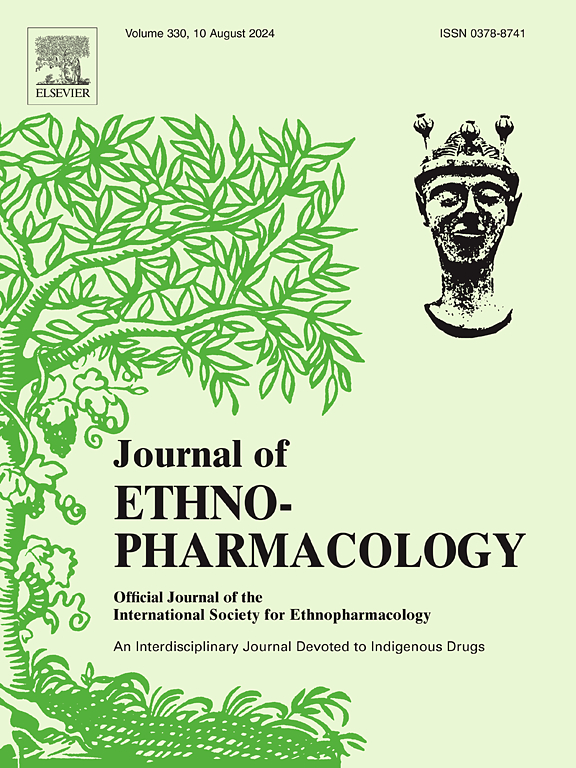Phthalide extract from stems and leaves of Ligusticum chuanxiong attenuates cerebral I/R injury via CaSR-mediated NLRP3 inflammasome suppression
IF 5.4
2区 医学
Q1 CHEMISTRY, MEDICINAL
引用次数: 0
Abstract
Ethnopharmacological relevance
The stems and leaves of Ligusticum chuanxiong (“Miwu") have been historically documented in ancient texts such as “Shennong Bencao Jing Jizhu" for alleviating conditions like stroke and dizziness. However, the therapeutic potential of phthalide extract from the stems and leaves of Ligusticum chuanxiong (SLECX) needs further investigate.
Aim of the study
This study aimed to investigate the neuroprotective effects of SLECX against cerebral ischemia-reperfusion (I/R) injury and elucidate its mechanism of action.
Materials and methods
SLECX was prepared from stems and leaves of Ligusticum chuanxiongvia ethanol extraction and macroporous resin purification, with major phthalides quantified by HPLC and LC-MS/MS. Neuroprotective effects were evaluated in Middle cerebral artery occlusion (MCAO) rats and oxygen-glucose deprivation/reoxygenation (OGD/R)-induced HT22 cells. Molecular docking, surface plasmon resonance (SPR), and calcium imaging were employed to identify key active compounds targeting CaSR and NLRP3.
Results
SLECX pretreatment significantly reduced cerebral infarct volume (29.6 % → 16.4 %), alleviated neurological deficits, and attenuated brain edema in MCAO rats. It suppressed pro-inflammatory cytokines and inhibited CaSR/NLRP3 inflammasome activation in both in vivo and in vitro models. Molecular docking and SPR identified chuanxiongnolide B as a primary active compound, exhibiting strong CaSR binding (KD = 1.36 × 10−4 M) and reducing OGD/R-induced Ca2+ overload and apoptosis in HT22 cells. SLECX also restored blood-brain barrier (BBB) integrity by upregulating zona occludens 1 (ZO-1) and Occludin.
Conclusions
SLECX mitigates cerebral I/R injury by inhibiting CaSR-mediated NLRP3 inflammasome activation, with chuanxiongnolide B as a pivotal bioactive component.

川芎茎叶邻苯酞提取物通过抑制casr介导的NLRP3炎性体减轻脑I/R损伤
川芎的茎和叶在《神农本草经己经》等古籍中有历史记载,用于缓解中风和头晕等疾病。然而,川芎茎叶邻苯酞提取物的治疗潜力有待进一步研究。本研究旨在探讨SLECX对脑缺血再灌注(I/R)损伤的神经保护作用,并阐明其作用机制。材料与方法以川芎茎叶为原料,经乙醇提取和大孔树脂纯化制备sslecx,并采用HPLC和LC-MS/MS对主要邻苯酞进行定量分析。研究了大脑中动脉闭塞(MCAO)大鼠和氧葡萄糖剥夺/再氧化(OGD/R)诱导的HT22细胞的神经保护作用。利用分子对接、表面等离子体共振(SPR)和钙成像技术鉴定靶向CaSR和NLRP3的关键活性化合物。结果slecx预处理显著降低MCAO大鼠脑梗死体积(从29.6%→16.4%),减轻神经功能缺损,减轻脑水肿。在体内和体外模型中,它抑制了促炎细胞因子,抑制了CaSR/NLRP3炎性体的激活。分子对接和SPR鉴定川芎烯内酯B为主要活性化合物,具有较强的CaSR结合(KD = 1.36 × 10−4 M),可减少OGD/ r诱导的HT22细胞Ca2+超载和凋亡。SLECX还通过上调闭塞带1 (ZO-1)和Occludin来恢复血脑屏障(BBB)的完整性。结论sslecx通过抑制casr介导的NLRP3炎性体激活来减轻脑I/R损伤,川芎烯内酯B是其关键生物活性成分。
本文章由计算机程序翻译,如有差异,请以英文原文为准。
求助全文
约1分钟内获得全文
求助全文
来源期刊

Journal of ethnopharmacology
医学-全科医学与补充医学
CiteScore
10.30
自引率
5.60%
发文量
967
审稿时长
77 days
期刊介绍:
The Journal of Ethnopharmacology is dedicated to the exchange of information and understandings about people''s use of plants, fungi, animals, microorganisms and minerals and their biological and pharmacological effects based on the principles established through international conventions. Early people confronted with illness and disease, discovered a wealth of useful therapeutic agents in the plant and animal kingdoms. The empirical knowledge of these medicinal substances and their toxic potential was passed on by oral tradition and sometimes recorded in herbals and other texts on materia medica. Many valuable drugs of today (e.g., atropine, ephedrine, tubocurarine, digoxin, reserpine) came into use through the study of indigenous remedies. Chemists continue to use plant-derived drugs (e.g., morphine, taxol, physostigmine, quinidine, emetine) as prototypes in their attempts to develop more effective and less toxic medicinals.
 求助内容:
求助内容: 应助结果提醒方式:
应助结果提醒方式:


